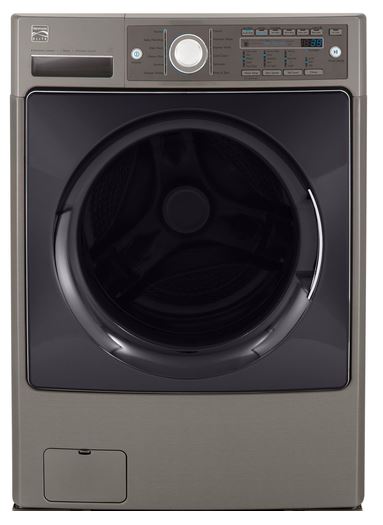
Kenmore 461970203975 Front-Loading Automatic Washer
About Kenmore
Kenmore is a brand of home appliances sold exclusively by the department store chain Sears and its online store. The brand includes a wide range of products such as refrigerators, ovens, dishwashers, washing machines, dryers, and vacuum cleaners. Kenmore products are designed to be reliable and durable, with many models featuring advanced technologies and energy-efficient features. While Kenmore products were once only available at Sears, they are now sold through other retailers as well.
Master Protection Agreements
Congratulations on making a smart purchase. Your new Kenmore” appliance is designed and manufactured for years of dependable operation. But like all products, it may require preventive maintenance or repair from time to time. That’s when having a Master Protection Agreement can save you money and aggravation.
Purchase a Master Protection Agreement now and protect yourself from unexpected hassle and expense.
The Master Protection Agreement also helps extend the life of your new appliance. Here’s what’s included in the Agreement:
- Expert service by our 12,000 professional repair specialists
- Unlimited service and no charge for parts and labor on all covered repairs.
- “No-lemon” guarantee – replacement of your covered product if more than three product failures occur within twelve months
- Product replacement if your covered product can’t be fixed
- Annual Preventive Maintenance Check at your request – no extra charge
- Fast help by phone – non-technical and instructional assistance on products repaired in your home, plus convenient repair scheduling’ Power surge protection against electrical damage due to power fluctuations’ Rental reimbursement.if repair of your covered product takes longer than promised
Once you purchase the Agreement, a simple phone call is all that it takes for you to schedule service. You can call anytime day or night, or schedule a service appointment online.
Sears has over 12,000 professional repair specialists, who have access to over 4.5 million quality parts and accessories. That’s the kind of professionalism you can count on to help prolong the life of your new purchase for years to come. Purchase your Master Protection Agreement today!
Some limitations and exclusions apply. For prices and information call 1-800-827-6655.
Sears installation Service
For Sears guaranteed professional installation of home appliances and items like garage door openers and water heaters, in the U.S.A. call 1-800-4-MY-HOME
Maintenance Agreements
Your purchase has added value because you can depend on Sears HomeCentral ®for service. With over 2,400 Service Technicians and access to over 9go,000 parts, and accessories, we have the tools, parts, knowledge, and skills to back our pledge: We Service What We Sell.
Your Kenmore ®appliance is designed, manufactured, and tested to provide years of dependable operation. Yet any major appliance may require service from time to time. The Sears Maintenance Agreement offers you an outstanding service program, affordably priced.
The Sears Maintenance Agreement
- Guarantees tomorrow’s service at today’s price.
- Eliminates repair bills resulting from normal wear and tear.
- Covers non-technical and instructional service calls.
- Provides an annual Preventive Maintenance Check, at your request, to ensure that your appliance is in proper running condition.
Some limitations apply. For information concerning Sears Home Central _’Maintenance Agreements, call 1-800-361-6665.
KENMORE ELITE WASHER WARRANTY
Limited Lifetime Warranty on Stainless Steel Drum
For the lifetime of the front-loading Kenmore washer from the date of purchase, Sears will replace the Stainless Steel wash drum due to defective material or workmanship. After the first year, you will be charged for labor.
Limited 10-Year Warranty on Plastic Tub*
For the second through the tenth year from the date of purchase,
Sears will replace the plastic tub if it is defective in material or workmanship. After the first year, you will be charged for labor.
Limited 5-Year Warranty on Gearcase Parts*
For the second through fifth years from the date of purchase,
Sears will replace any gearcase parts that are defective in material or workmanship. After the first year, you will be charged for labor.
Limited 2-Year Warranty on SENSOR SMART TM
Control Board
For two years from the date of purchase, Sears will replace the SENSOR SMART TM control board if it is defective in material or workmanship. You will be charged for labor after the first year. Full 1-Year Warranty on Mechanical and Electrical Parts For one year from the date of purchase, when this Kenmore Automatic washer is installed and operated according to the instructions that come with it, Sears will repair or replace any of its mechanical or electrical parts if they are defective in material or workmanship. Service must be provided by a Sears Service Department in the United States or Canada or an authorized agent.
Warranty Restriction
If this Kenmore Automatic washer is operated for any purpose other than private family use, all warranty coverage is restricted to 90 days from the date of purchase. Travel or transportation expenses for customers who reside in remote areas are not covered by this warranty.
Warranty Service
Warranty service is available by contacting the nearest Sears Service Center in the United States or Canada. This warranty applies only while the product is in use in the United States or Canada.
This warranty gives you specific legal rights and you may also have other rights which vary from state to state or province to province,
For Sears warranty information or to contact a Sears Service Center, please reference the service numbers located on the back page of this manual.
Sears, Roebuck and Co. D/817WA, Hoffman Estates, !L 60179 Sears Canada Inc. Toronto, Ontario, Canada MhB 2138 In Canada a different warranty may apply.
Product Record
In the space below, record your complete model number, serial number, and purchase date. You can find this information on the model and serial number label, as shown.
Have this information available to help you quickly obtain assistance or service when you contact Sears concerning your appliance.
- Model number 110
- Serial number
- Purchase date
Save these instructions and your sales receipt for future reference.
WASHER SAFETY
Your safety and the safety of others are very important.
We have provided many important safety messages in this manual and on your appliance. Always read and obey all safety messages.
- This symbol alerts you to potential hazards that can kill or hurt you and others.
- All safety messages will follow the safety alert symbol and either the word “DANGER” or “WARNING.” These words mean:
DANGER
- You can be killed or seriously injured if you don’t immediately follow instructions,
- You can be killed or seriously injured if you don’t follow instructions.
- All safety messages will tell you what the potential hazard is, tell you how to reduce the chance of injury, and tell you what can happen if the instructions are not followed.
IMPORTANT SAFETY INSTRUCTIONS
WARNING: TOreduce the risk of fire, electric shock, or injury to persons when using the washer, follow basic precautions, including the following:
Read all instructions before using the Kenmore Automatic washer.
- Do not wash articles that have been previously cleaned in, washed in, soaked in, or spotted with gasoline, dry-cleaning solvents, or other flammable, or explosive substances as they give off vapors that could ignite or explode.
- Do not add gasoline, dry-cleaning solvents, or other flammable, or explosive substances to the wash water. These substances give off vapors that could ignite or explode.
- Under certain conditions, hydrogen gas may be produced in a hot water system that has not been used for 2 weeks or more. HYDROGEN GAS IS EXPLOSIVE. If the hot water system has not been used for such a period, before using the washing machine, turn on all hot water faucets and let the water flow from each for several minutes. This will release any accumulated hydrogen gas. As the gas is flammable, do not smoke or use an open flame during this time.
- Do not allow children to play on or in the Kenmore Automatic washer. Close supervision of children is necessary when the washer is used near children.
- Before the front-loading Kenmore washer is removed from service or discarded, remove the door or lid.
- Do not reach into the washer if the drum, tub, or agitator is moving.
- Do not install or store the washer where it will be exposed to the weather.
- Do not tamper with controls.
- Do not repair or replace any part of the Kenmore Automatic washer or attempt any servicing unless specifically recommended in this manual or in published user-repair instructions that you understand and have the skills to carry out.
- See “Electrical Requirements” for grounding instructions.
SAVE THESE INSTRUCTIONS
INSTALLATION REQUIREMENTS
Tools and Parts
Assemble the necessary tools and supplies before beginning the washer installation. The parts supplied are in the washer drum.
Tools needed for connecting the water inlet hoses
- Pliers (that open to 19/_6in. [39.5 mm])
- Flashlight (optional)
Tools needed for installation
- Open-end wrench % in. (17 mm) and 1/2in. (13 mm)
- Level
- Woodblock (2″ x 4″)
- Ruler or measuring tape
Parts supplied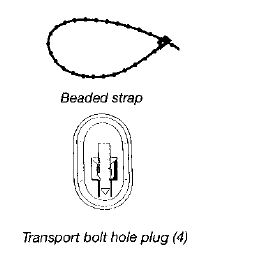
Alternate Parts
Parts listed are available from your local Sears store or Sears Service Center. For further information, please call 1-800-4-MYHOME ®(1-800-469-4663).
Optional Pedestal
A pedestal may be purchased separately for this Kenmore Automatic washer. This pedestal will add about 13 in. (33 cm) to the height of your unit for a total vertical height of approximately 51 in. (130 cm).
This pedestal (with a storage drawer) is available in three colors:
- White – Part Number 42842
- Bisque – Part Number 42844
- Graphite – Part Number 42846
To order, call your local Sears store. For further information, please call 1-800-4-MY-HOME _ (1-800-469-4663).
Location Requirement
Selecting the proper location for your Kenmore Automatic washer improves performance and minimizes noise and possible washer “walk.”
Your washer can be installed under a custom counter, or in a basement, laundry room, closet, or recessed area. (See “Brain System.”)
Companion appliance location requirements should also be considered. Proper installation is your responsibility.
You will need
- A water heater set to deliver 120°F (49°C) water to the Kenmore Automatic washer.
- A grounded electrical outlet located within 5 ft (1,5 m) of where the power cord is attached to the back of the Kenmore Automatic washer. (See “Electrical Requirements.”)
- Hot and cold water faucets located within 4 ft (1.2 m) of the hot and cold water fill valves, and water pressure of 20-100 psi (137.9-689.6 kPa).
- A level floor with a maximum slope of 1 in. (2.5 cm) under the entire washer. Installing the washer on the carpeting is not recommended.
- A sturdy and solid floor to support the washer with a total weight (water and load) of 400 Ibs (180 kg).
Do not operate your washer in temperatures below 32°F (0°C). Some water can remain in the Kenmore Automatic washer and can cause damage in low temperatures.
Washer Dimensions
Custom under reounter installation
The dimensions shown are for the minimum spacing allowed
Recessed area or closet installation
The dimensions shown are for the minimum spacing allowed.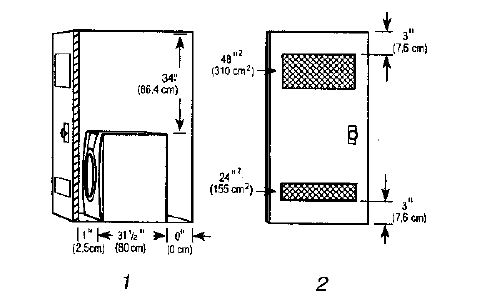
- Additional spacing should be considered for ease of installation and servicing.
- Additional clearances might be required for wall, door, and floor moldings.
- Additional spacing of 1 in. (2.5 cm) on all sides of the Kenmore Automatic washer is recommended to reduce noise transfer.
- For closet installation, with a door, the minimum ventilation openings at the top and bottom of the door are required (view 2), Louvered doors with equivalent ventilation openings at the top and bottom are acceptable
Drain System
The washer can be installed using the standpipe drain system (door or wall), the laundry tub drain system, or the floor drain stem. Select the drain hose installation method you need. (See “alternate Parts.”)
Standpipe drain system – wall or floor (view 1 & 2)
The standpipe drain requires a minimum diameter standpipe of 2 in, (5 cm). The minimum carry-away capacity can be no less than 17 gals. (64 L) per minute.
The top of the standpipe must be at least 30 in. (76.2 cm) high and no higher than 96 in. (2.4 m) from the bottom of the Kenmore Automatic washer.
Laundry tub drain system (view 1)
The laundry tub needs a minimum of 20 gals. (76 L) capacity. The top of the laundry tub must be at least 30 in. (76.2 cm) above the floor.
Floor drain system (view 2)
The floor drain system requires a siphon break that may be purchased separately. (See “Alternate Parts.”)
The siphon break must be a minimum of 28 in, (71 cm) from the bottom of the Kenmore Automatic washer, Additional hoses might be needed.
- Electrical Shock Hazard
- Plug into a grounded 3-prong outlet.
- Do not remove the ground prong.
- Do not use an adapter.
- Do not use an extension cord.
- Failure to follow these instructions can result in death, fire, or electrical shock.
- A 120-volt, 60-Hz., AC-only, 15- or 20-ampere, fused electrical supply is required. A Time-delay fuse or circuit breaker is recommended. It is recommended that a separate circuit serving only this appliance be provided.
- This washer is equipped with a power supply cord having a 3-prong ground plug.
To minimize possible shock hazards, the cord must be plugged into a mating, 3-prong, ground-type outlet, grounded in accordance with local codes and ordinances. If a mating outlet is not available, it is the personal responsibility and obligation of the customer to have the properly grounded outlet installed by a qualified electrician. - If codes permit and a separate ground wire is used, it is recommended that a qualified electrician determine that the ground path is adequate.
- Do not ground to a gas pipe,
- Check with a qualified electrician if you are not sure the washer is properly grounded.
- Do not have a fuse in the neutral or ground circuit.
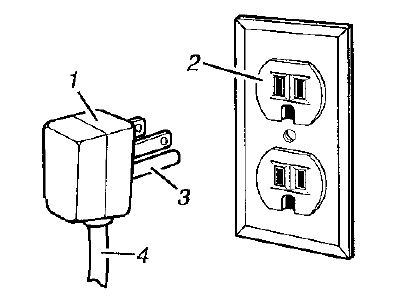
- 3-prong grounding plug
- 3-prong grounding-type wall receptacle
- Grounding prong
- Power supply cord
GROUNDING INSTRUCTIONS
For a grounded, cord-connected washer:
- This washer must be grounded. In the event of a malfunction or breakdown, grounding will reduce the risk of electrical shock by providing a path of least resistance to electric current. This washer is equipped with a cord having an equipment-grounding conductor and a grounding plug. The plug must be plugged into an appropriate outlet that is properly installed and grounded in accordance with all local codes and ordinances.
WARNING: Improper connection of the equipment-grounding conductor can result in a risk of electric shock. Check with a qualified electrician or serviceman if you are in doubt as to whether the appliance is properly grounded. - Do not modify the plug provided with the appliance – if it will not fit the outlet, have a proper outlet installed by a qualified electrician.
Excessive Weight Hazard
Use two or more people to move and install the Kenmore Automatic washer.
Failure to do so can result in back or another injury.
IMPORTANT: Position the washer so that the rear of the unit is within approximately 3 ft (90 cm) of the final location.
There are 4 bolts in the rear panel of the Kenmore Automatic washer that support the suspension system during transportation.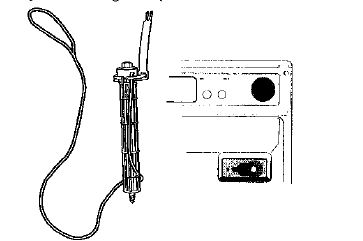
- Using a ½ in. (13 mm) wrench, loosen each of the bolts.
- Once the bolt is loose, move it to the center of the hole and completely pull out the bolt, including the plastic spacer covering the bolt and the cable attached to the bolt. The power cord will be attached to all 4 bolts
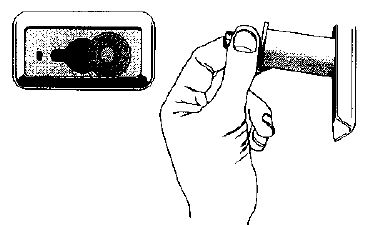
- Once all 4 bolts are removed, remove the power cord from each bolt holder, and discard bolts, plastic spacers, and cables.
- Close the holes with the transport bolt-hole plugs.
Connect the Inter Hoses
Connect the inlet hoses to the water faucets Make sure the washer drum is empty.
- Using pliers, check for the tightness of hose couplings already attached to the Kenmore Automatic washer.
NOTE: Do not overtighten. Damage to the connection can result. - Attach the hose with the red color indicator to the hot water faucet. Screw on the coupling by hand until it is seated on the washer.
- Attach the hose with the blue color indicator to the cold water faucet. Screw on the coupling by hand until it is seated on the Kenmore Automatic washer.
- Using pliers, tighten the couplings with an additional two-thirds turn.

NOTE: Do not overtighten. Damage to the coupling can result. - Turn on the water faucets and check for leaks.
NOTE: Replace inlet hoses after 5 years of use to reduce the risk of hose failure. Record hose installation or replacement dates on the hoses for future reference. Periodically inspect and replace hoses if bulges, kinks, cuts, wear, or leaks are found.
Route The Drain Hoses
Proper routing of the drain hose protects your floors from damage due to water leakage. Carefully read and follow these instructions.
The drain hose is connected to your washer
To prevent drain water from going back into the washer:
- Do not straighten the drain hose, and do not force the excess drain hose into the standpipe. The hose should be secure, but loose enough to provide a gap for air.
- Do not lay an excess hose on the bottom of the laundry tub.
Floor drain
You may need additional parts. (See Floor Drain under “Alternate Parts.”)
Secure the Drain Hose
- Drape the power cord over the Kenmore Automatic washer top.
- Secure the drain hose to the laundry tub leg or standpipe with the beaded trap to provide

- If the washer faucets and the drain standpipe are recessed (see illustration 3), put the hooked end of the drain hose in the standpipe.
- Tightly wrap the beaded strap around the water inlet hoses and the drain hose.
- Do not force the excess drain hose into the standpipe.
For a permanently connected washer
This washer must be connected to a grounded metal, permanent wiring system, or an equipment grounding conductor must be run with the circuit conductors and connected to the equipment-grounding terminal or lead on the appliance
Level The Washer
Properly leveling your washer prevents excessive noise and vibration.
- Check the levelness of the washer by placing a level on the top edge of the washer, first side-to-side than front-to-back.
If the washer is against a wall, move the Kenmore Automatic washer out slightly before tipping back, If the washer is not level, first prop the front with a wood block (2″ x 4″) and adjust the feet as necessary; then prop the back and adjust feet as necessary.
Repeat this step until the washer is level. - After the washer is level, use a % in. (17 mm) open-end wrench to turn the nuts on the feet tightly against the washer cabinet.
All 4 feet must be tightened• If the nuts are not tight against the washer cabinet, the washer may vibrate• - Slide the washer to its final location.
- Confirm the level of the Kenmore Automatic washer.
Complete Installation
- Check the electrical requirements. Be sure that you have the correct electrical supply and the recommended grounding method. (See “Electrical Requirements.”)
- Check to be sure all parts are now installed. If there is an extra part, go back through the steps to see which step was skipped.
- Check to be sure you have all of your tools.
- Dispose of/recycle all packaging materials.
- Check to be sure the water faucets are on.
- Check for leaks around faucets and inlet hoses.
Electrical Shock Hazard- Plug into a grounded 3-prong outlet.
- Do not remove the ground prong.
- Do not use an adapter.
- Do not use an extension cord.
- Failure to follow these instructions can result in death, fire, or electrical shock.
- Plug into a grounded 3-prong outlet.
- Read “Washer Use.”
- To test and clean your Kenmore Automatic washer, measure the normal recommended amount of powdered or liquid High Efficiency (HE) detergent or V4 the normal recommended amount of regular powdered or liquid detergent. Pour the detergent into the detergent dispenser. Select NORMAL/CASUAL, and then select START. Allow the washer to complete one whole cycle•
FEATURES AND BENEFITS
SENSOR SMART TM Electronic Controls
Flexible electronic controls are easy to use whether you are a beginner or an expert.
Detergent Advantage System Dispenser
The four compartments in the dispenser allow the loading of all laundry additives before the washer is started. The additives will be dispensed into Wash at the optimal time for high-performance cleaning. TIMED BLEACH TM release is included in the detergent advantage system. The detergent is added at the beginning of the cycle and the bleach is added after the enzymes have had a chance to do their cleaning. The fabric softener is dispensed in the rinse cycle. The Detergent Advantage System Dispenser tray is easily removed for cleaning.
Auto Water Level
Adjusting to the size of the load, this feature allows the Kenmore Automatic washer to use the minimal amount of water needed to clean and rinse the clothes. With a low water level, you can obtain the same results with smaller amounts of additives. Because only the required amount of water is used, the washer saves energy, too.
Larger Load Size
Since there is no agitator, you can wash larger, bulkier items like an average size sleeping bag. You are also able to wash more clothes at one time, which means fewer loads. You can wash a pillow or a large stuffed teddy bear.
Suspension System
To reduce washer “walk” and “off-balance” conditions, your new Kenmore Automatic washer combines:
- 2 Springs to isolate vibration
- 4 Shock absorbers at the washer base to minimize movement
Stainless Steel Drum
The Stainless Steel drum eliminates corrosion and enables higher spin speeds for more water extraction, reducing drying time.
Adaptive Variable Speed Motor
The motor adapts to the load size and to the cycle selected to give the optimum cleaning, rinsing, and spinning conditions. The motor can handle slow speeds needed for wool and delicate items and is powerful enough to drive a large clothes load into a 1200 rpm spin.
High-Efficiency Wash System
Your new front-loading, high-efficiency Kenmore Automatic washer saves time with fewer, larger loads, conserves resources, and lowers your water and energy bills too.
Spin Speeds
This washer automatically selects the spin speed based on the cycle selected. This factory setting can be changed, however. This washer offers up to six different spin speed choices.
Thermal Optimizer
The heating system ensures that the wash water is heated to the preset temperature for Heavy Duty, Whftest Whites, Sanitary, and the Stain Treat option. It also provides “stepped cleaning” when using the sanitary cycle or the stain treatment option. “Stepped cleaning” starts the wash cycle with warm water to remove stains (such as blood or grass). The water continues heating in order to remove stains such as dirty mechanical oil. During the sanitary cycle, the thermal optimizer can heat the water to temperatures that will destroy 99.999% of the three common types of bacteria found in the soiled laundry.
Add A Garment
When lighted, Express Wash, Normal/Casual, Heavy Duty, Whitest Whites, and Sanitary can be paused and the door unlocked so you can add a garment that may have been forgotten when loading the Kenmore Automatic washer. The ADD A GARMENT status light will stay lit for the first 8 minutes of a cycle.
CATALYSIS Cleaning Action with Direct Injection
A concentrated detergent solution is sprayed onto the clothes at the beginning of the cycle to ensure that the detergent comes into contact with the clothes as quickly as possible, removing stains from your clothes without pre-treating
Dynamic Balance
A precision balancing system that allows the Kenmore Automatic washer to reach spin speeds of 1200 rpm. The washer spins faster so that clothes coming out of the washer will dry faster. In addition, if the Dynamic Balance system detects off-balance loads during spinning, it redistributes the clothes so that they are evenly balanced.
WASHER USE
Fire Hazard
- Never place items in the washer that are dampened with gasoline or other flammable fluids.
- No washer can completely remove oil.
- Do not dry anything that has ever had any type of oil on it (including cooking oils).
- Doing so can result in death, explosion, or fire.
WARNING: To reduce the risk of fire, electric shock, or injury to persons, read the IMPORTANT SAFETY INSTRUCTIONS before operating this appliance.
The following is a guide to using your washer. Please refer to specific sections of this manual for more detailed information. Do not store laundry products on the top surface of this washer. Vibration is normal during the operation.
First Wash Cycle Without Laundry
Before washing clothes for the first time, choose the NORMAL/ CASUAL cycle and run it without clothes. After installation, if a complete cycle has not been run without clothes, use V_the normal recommended amount of powdered or liquid High Efficiency (HE) detergent or 1/4the normal recommended amount of regular powdered or liquid detergent. This initial cycle serves to ensure the interior is clean before washing clothes.
To load washer
Open the washer door by pulling on the handle. Sort laundry according to color and type of fabric. Place a load of sorted clothes in the washer• Do not overload the washer.
Overloading can cause poor cleaning.
- The washer can be fully loaded, but not tightly packed. The washer door should close easily.
- Mix large and small items. Avoid washing a single item. Load evenly.
- It is recommended that you wash small items such as infant socks in a mesh garment bag.
- When unloading garments, occasionally check under the rubber rim at the front of the tub for small items.
- Close the washer door by pushing it firmly until the lock clicks. The washer door will remain locked during the wash cycle.
NOTE: After any wash cycle is completed, the door must be opened and then closed before a new cycle can begin. The door can be opened only if PAUSE/CANCEL is selected while the ADD A GARMENT light is glowing or if the cycle has been canceled. See “To Cancel a Cycle.” - Open the Dispenser Drawer and add laundry products to the detergent, bleach, or fabric softener compartments. Close the drawer slowly to avoid spills. See “Using the Dispenser.”
NOTE: For best performance, use High-Efficiency detergents. The package for this type of detergent will be marked “HE” or “High Efficiency.” The HE_t “wash action” along with less water could create too much sudsing with a regular detergent. - Turn on the front-loading Kenmore washer by selecting one of the WASH CYCLES. The indicator light for the selected cycle will glow. When selecting a Wash Cycle, the preset options, Water Temp, spin speed, and soil level for the selected cycle will glow. The display shows the estimated time remaining. The preset settings provide the recommended fabric care for the selected cycle. See “Wash Cycles.”
- Select the desired OPTIONS. Not all Options are available with all cycles. See “Options.”
- Select the desired MODIFIERS. Not all Modifiers are available with all Cycles and Options. See “Modifiers.”
- If desired, select the END OF CYCLE SIGNAL. The signal is helpful when you are washing items that should be removed from the washer as soon as it stops. Select HIGH or LOW.
- To begin the wash cycle immediately
Select and hold START (for approximately 1 second).- If you do not select START within 5 minutes of choosing a cycle, the washer automatically shuts off.
- When the wash cycle is complete, the CLOTHES CLEAN status light glows, the door unlocks, and the wash load can be removed from the washer. The washer powers down automatically 5 minutes after the cycle is complete and the CLOTHES
- The CLEAN light goes off. To power down the front-loading Kenmore washer manually after the wash cycle is complete,
select PAUSE/CANCEL once.
- To begin the wash cycle later Select DELAY until the desired delay time (in hours) shows in the Estimated Time Remaining display. Select START. The countdown to the wash cycle will show in the display window
Using the Dispenser
- Your new washer has a dispenser drawer with four separate compartments for your laundry products–two are for detergent, one is for liquid chlorine bleach, and one is for liquid fabric softener. Laundry products are diluted and dispensed automatically at the proper time during the wash cycle, making it unnecessary for you to return to the washer during the cycle to add them.
- It is normal for small amounts of water to remain in the dispensers when the wash cycle is complete.
- Do not put laundry additives directly into the washtub. Always use the proper dispensers when adding laundry products.
Choosing the Right Detergent
For best washing performance, use a High Efficiency (HE), or low-sudsing, detergent. Regular detergents may cause oversudsing in the washer. If a High-Efficiency detergent is unavailable, use the recommended amount of regular detergent.
Most detergents formulated for hand-washing are not meant for front-loading Kenmore washers and may cause oversudsing. Start with V4 the recommended amount. If oversudsing occurs, try a detergent formulated for high-efficiency washers.
To fill dispenser compartments
- Pull out the dispenser drawer.
- Add the desired laundry product to the proper compartment.
- Push in the dispenser drawer carefully and completely (to avoid spillage).
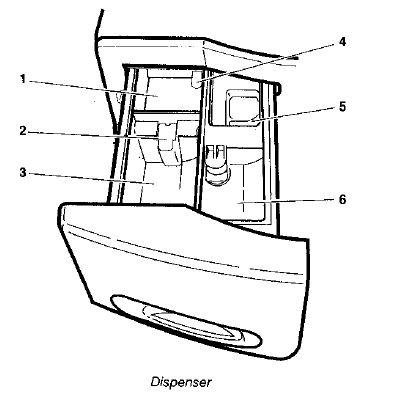
- Prewash detergent compartment
- Separator
- Main Wash detergent compartment
- Dispenser release lever
- Bleach compartment
- Fabric softener compartment
Prewash detergent compartment
- Add detergent to this compartment when using the Prewash option c” Auto Soak. Liquid or powdered detergent may be used in this compartment. The detergent will automatically be dispensed during Prewash if the Prewash option is selected or during the soak time if Auto Soak is selected.
- If your use High Efficiency (HE) detergent, add /3 the recommended amount to the prewash compartment and 2/3 the recommended amount to the main wash compartment.
- If you use regular detergent, add 1/6 of the recommended amount to the prewash compartment and 1/3 of the recommended amount to the main wash compartment.
Main Wash detergent compartment
Add liquid or powdered detergent to this compartment for your main wash cycle. The detergent separator must always be in place, either in the front or back position.
IMPORTANT: If you are using the Prewash option, the Auto Soak with a wash cycle, or Delay, powdered detergent must be used in the main wash compartment since liquid detergents may seep out of the main wash compartment during the prewash, soak time, or delay before the main wash begins.
- Do not fill beyond the “MAX” level.
- Liquid or powdered color-safe bleach may be added to the Main Wash compartment along with the same type of detergent, liquid or powdered.
- Liquid detergent: Put the SEPARATOR in the front position, between the guides, as shown following. There will be no gap between the bottom of the wash cycle detergent compartment and the bottom of the separator.
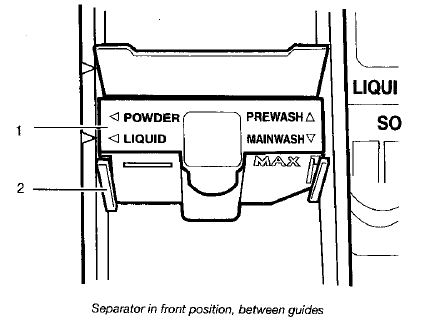
Separator in front position, between guides- Separator
- Guide
- Powdered detergent: Put the SEPARATOR in the back position, behind the guides, as shown following. There will be a gap between the bottom of the wash cycle detergent compartment and the bottom of the separator.

Separator in the back position, behind guides
- Separator
- Guide
NOTE: The separator will be in the powder (back) position when shipped from the factory
Bleach compartment
(Number 5 in Dispenser Illustration)
Add NO MORE THAN 1/3 cup (80 mL) liquid chlorine bleach to this compartment. The bleach will be automatically diluted and dispensed at the best time during the first rinse after the wash cycle. This compartment cannot dilute powdered bleach.
- Always measure liquid chlorine bleach. Use a measuring cup with a pour spout; do not guess.
- Do not fill beyond the “MAX” level. Overfilling could cause severe garment damage.
Fabric Softener compartment
(Number 6 in Dispenser Illustration) Add % cup (60 mL) of liquid fabric softener to this compartment. Fabric softener will be automatically dispensed in the final rinse.
- Do not fill beyond the “MAX” level.
Pausing or Restating
- To pause the washer at any time, select PAUSE/CANCEL
- To continue the cycle, select and hold START (for approximately t second).
Changing Cycles, Options, and Modifiers
Not all Options and Modifiers are available with all Cycles. Cycles, Options and Modifiers can be changed anytime before START is selected. Options and Modifiers can be changed anytime after START is selected and before the start of the selected Option or Modifier.
To cancel a cycle and select a new cycle
- Select PAUSE/CANCEL twice.
- Select the desired cycle.
- Select the desired OPTIONS.
- Select and hold START (for approximately 1 second) to restart the front-loading Kenmore washer at the beginning of the new cycle.
To cancel a cycle
- Select PAUSE/CANCEL twice.
- The washer powers down, the door unlocks, and clothes can be removed.
NOTE: If the water level or the temperature is too high, the washer will drain automatically before the door unlocks.
To drain the washer manually
- Select PAUSE/CANCEL
- Select DRAIN/SPIN.
- Select and hold START (for approximately 1 second) to begin the drain.
- When the spin is complete, the door unlocks. Items can be removed from the washer.
Status Light
These lights show which portion of the cycle the front-loading Kenmore washer is operating They also indicate when you can add an additional item to the wash cycle and when the controls are locked
- STATUS
- ADD GARMENT
- SOAK! PREWASH
- WASH
- RINSE
- SPIN
- CLOTHES CLEAN
- CONTROL LOCKED
To change Options or Modifiers after the cycle has started
- Select PAUSE/CANCEL
- Select the desired OPTIONS or MODIFIERS.
- Select and hold START (for approximately 1 second) to continue the cycle.
Adding items
You can add items to the washer after the cycle has started for Express Wash, Normal/Casual, Heavy Duty, Whitest Whites, and Sanitary if the ADD A GARMENT status light is glowing,
To add items
- Select PAUSE/CANCEL The washer door unlocks, and items can be added.
- To continue the cycle, close the door and select and hold START (for approximately 1 second).
Clothes Clean
The Clothes Clean light stays on for 5 minutes after the cycle is complete. The washer will then power down.
Locking controls
The Control Lock prevents unintended use of the washer. You can also use the control lock feature to prevent unintended cycle or option changes during a cycle. When CONTROL LOCKED is lit, all buttons are disabled except for Pause/Cancel and Start.
You can lock the controls while the front-loading Kenmore washer is operating.
To lock the controls
Select and hold DRAIN/SPIN for 3 seconds.
The CONTROL LOCKED status light glows.
To unlock the controls
Select and hold DRAIN/SPIN for 3 seconds until the CONTROL LOCKED Status light turns off.
Estimated Time Remaining
The cycle times vary automatically based on your water pressure, water temperature, detergent, and clothes load, The cycle time will be extended if oversudsing occurs or the load is unbalanced.
Cycles
Wash Cycles
Choose Wash Cycles by selecting the button next to the desired cycle. Each cycle is designed for different types of fabric and soil levels.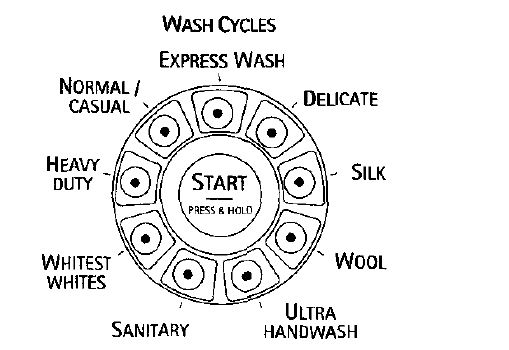
- Each cycle has a preset Soil Level (cycle time), Water Temperature, and Spin Speed, and may have preset Options. The preset settings provide the recommended fabric care for the selected cycle.
- The preset settings can be changed anytime before START is selected. Not all Options and Modifiers are available with all Cycles. (To change settings after the cycle has started, select PAUSE/CANCEL then select the desired settings. Select and hold START (for approximately 1 second) to continue the cycle.)
Reset cycle settings
Each cycle has a preset Cycle Time, Water Temp, and Spin Exceed. The preset settings provide the recommended fabric care for the selected cycle. See chart.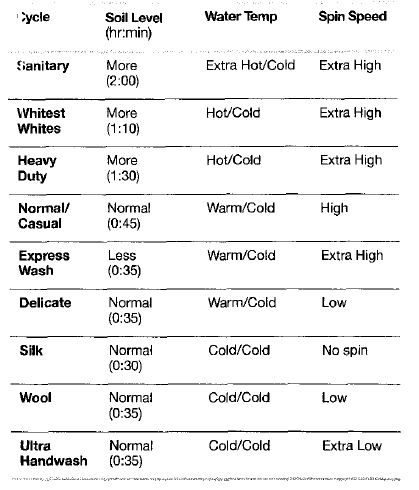
Sanitary
Use this cycle to clean heavily soiled colorfast fabrics. This cycle combines a very hot water temperature and fast speed tumbling to help ensure the removal of heavy soils and stains. It is recommended that you set your hot water heater to 120°F (49°C) to ensure proper performance during this cycle. The Sanitary cycle also helps eliminate 99.999% of 3 common infectious bacteria, even when no bleach is used. Extra high-speed spin helps shorten drying time.
Whitest Whites
This cycle is specially designed for cleaning loads of soiled white fabrics with the addition of bleach. Hot washing temperatures assure optimal bleach activity. An additional rinse provides optimal rinse performance to avoid chlorine residues on your laundry. This cycle combines fast-speed tumbling, longer wash time, and extra high-speed spin to shorten drying time
Heavy Duty
Use this cycle to wash loads of sturdy, colorfast fabrics and normally soiled garments. This cycle combines fast-speed tumbling, longer wash time, and extra high-speed spin to shorten drying times. If the water temperature is lower than needed for this cycle, the heater will warm the water to the optimum temperature.
NOTE: Stain Treat {s a default option for this cycle. To ensure the best performance, the water is heated as the cycle progresses. This gradual heating assists in the removal of organic soils such as blood. Stain Treat must be turned off to change the modifiers
Normal/Casual
Use this cycle to wash loads of no-iron fables such as sports shirts, blouses, casual business clothes, permanent press blends, cotton and linens, and synthetic fabrics. This cycle combines medium-speed tumbling, high sp(ed spin, and a load-cooling process to reduce wrinkling.
Express Wash
Use this cycle to wash small loads of lightly soiled garments that are needed in a hurry. This cycle combines full-speed tumbling, a shortened wash time, and extra high-speed spin to shorten drying time.
Delicate
Use this cycle to wash sheer fabrics and lingerie. This cycle combines low-speed tumbling and low-speed spin for gentle fabric care.
Silk
Use this cycle to clean washable silk garments. (Check label instructions to make sure that the garment is washable.) This cycle gently tumbles and drains without spinning to gently clean garments and minimize wrinkling. Because there is no spinning action, garments will contain a higher amount of water at the end of this cycle.
Wool
Use this cycle to clean washable woolen garments. (Check label instructions to make sure that the garment is washable.) This cycle features gentle tumbling and low-speed spin to minimize creasing and shrinkage.
Ultra Handwash
Use this cycle to clean hand-washable and special-care garments. Similar to the way garments are hand washed in a sink, the wash action of this cycle combines periods of extra low-speed tumbling and soaking. Extra low-speed spin reduces wrinkling.
Extra Cycles
Extra Cycles can be chosen by selecting the button above the desired cycle. You can change the selection anytime before START is selected.
Rinse/Spin
Use this cycle to get a rinse and spin only. This cycle combines fast-speed tumbling and extra high-speed spin. If desired, you can reduce the spin speed by selecting the speed you want from the SPIN SPEED modifier.
Rinse/Spin is useful for
- Loads that need rinsing only.
- Adding fabric softener to a load using the fabric softener dispenser.
Drain/Spin
Use this cycle to drain your front-loading Kenmore washer or to drain and spin your wash load. The spin speed is preset to extra high. If desired, you can reduce the spin speed by selecting the speed you want from the SPIN SPEED modifier.
NOTE: Loads of synthetics, delicate fabrics, hand washables, and woolens should be drained with no spin or low spin to avoid fabric stress.
As with any new product, you will hear sounds that you are not accustomed to. You may hear various sounds when the door is locked or unlocked, and during the washing, rinsing, or spinning process. Between changes in wash actions, there will be momentary pauses. You will hear water spraying and splashing during the wash and rinse cycles. These new sounds and pauses are part of normal front-loading Kenmore washer operation. (See “Troubleshooting.”)
Options
You can customize your wash by adding OPTIONS to your cycle selections. You can add or change an option after starting a cycle anytime before the selected option begins. Not all Options are available with all cycles
- See the “Laundry Guide” section for an overview of possible options for each Wash Cycle selection.
- You can select more than one option for a cycle. Some options cannot be added to some cycles, for example, Stain
The treat cannot be added to the Express Wash cycle. - If an option is available with a selected cycle, the light for that option will glow when selected.
- If an option is unavailable with a selected cycle, there will be a short tone and the light for that option will not glow when selected.
Prewash
- Use this option for loads of heavily soiled items that need pretreatment. This option adds a 15-minute prewash and drains to the main wash cycle.
- Add detergent to the Prewash and Main Wash compartments of the Dispenser Drawer.
- When using Prewash, do not use liquid detergent in the Main Wash compartment. Use powdered detergent for the main wash cycle.
NOTE: The Prewash and Auto Soak options cannot be selected in the same cycle.
Stain Treat
Use this option for heavily soiled loads that need improved stain treatment. When Stain Treat is selected, the water temperature of the selected wash cycle is automatically set to warm. The water will then be heated to a hot water temperature to aid in stain removal. This option will provide optimal removal of organic stains such as blood.
NOTE: If Stain Treat is selected with the Sanitary cycle the water will be heated to a very hot temperature.
Auto Soak
Use the Auto Soak option for loads of heavily soiled cotton, linen, polyester, or nylon with set-in stains. During Auto Soak, water will be added to the drum and the laundry will be equally distributed by a short tumbling phase. The laundry will then be soaked by phases without drum movement. After soaking, the Kenmore Automatic washer drains without spinning.
Added to e Wash Cycle: A 30-minute soak time is added to the main wash cycle to improve the removal of set-in stains.
- Add detergent to both the Prewash and Main Wash compartments of the Dispenser Drawer.
NOTE: The Auto Soak and Prewash options cannot be selected in the same cycle. Use powdered detergent for the main wash cycle because liquid detergent will seep into the front-loading Kenmore washer during Auto Soak. - Select a Wash Cycle.
- Select AUTO SOAK.
NOTE: For cycles with hot wash temperatures, the soak temperature will be set to warm; otherwise, the soak temperature will be the same as the wash temperature. - Select and hold START (approximately 1 second). After soaking, the Kenmore Automatic washer drains and the wash cycle starts.
Without a Wash Cycle: Provides a soak time with warm or cold water followed by the drain.
- Add detergent only to the Prewash compartment of the Dispenser Drawer.
- Select DRAIN/SPIN or RINSE/SPIN first; then AUTO SOAK.
- Choose the desired soak temperature.
- Select and hold START (approximately 1 second).
2nd Rinse
A second rinse can be used to ensure the removal of detergent or bleach residue from garments. This option provides an additional rinse with the same water temperature as the first rinse.
Extended Spin
Use this option to add an additional spin to any cycle to improve the “fluff” of your laundry, reduce drying time, and to save energy.
Modifiers
Preset cycle settings of Water Temperature, Wash/Rinse, and Spin Speed can be changed. You can change a modifier after starting a cycle anytime before the selected Modifier begins. Not all Modifiers are available with all options and cycles.
MODIFIERS
- To change the water temperature, select the WATER TEMP button until the desired setting glows.
- To change the spin speed, select the SPIN SPEED button until the desired setting glows.
- To change cycle time, select the SOIL LEVEL button.
- To change the loudness of the End of Cycle Signal, select END of CYCLE SIGNAL.

Wash/Rinse Temp
Select a water temperature based on the type of load you are washing. Use the warmest water safe for fabrics. Follow garment label instructions.
Warm rinses leave the loads dryer than cold rinses. Warm rinses increase wrinkling. In cold climates, a warm rinse makes the load more comfortable to handle. Cold rinses save energy.
Temperature Guide
In wash water temperatures colder than 70°F (21°C), detergents do not dissolve well. Soils may be difficult to remove
Auto Temp Control
ATC(Auto Temp Control) electronically senses and maintains a uniform water temperature. ATC regulates incoming hot and cold •water. The ATC is automatically turned ON when a cycle is selected. (See “Preset Cycle Settings’ in “Cycles.”)
- ATC ensures consistent cleaning.
- ATC works for the wash temperature with Extra Hot/Cold,
Hot/Cold, Warm/Warm, Warm/Cold, and Cold/Cold settings. - The Cold rinse temperatures depend on the cold water at your faucet.
- For the Tap Cold/Cold setting, both wash and rinse temperatures depend on the cold water at your faucet.
- The Warm rinse setting regulates the water temperature at approximately 104°F (40°C).
Refer to this chart for suggested load types and their corresponding cycles. Listed to the right are the options available to each of these washer cycles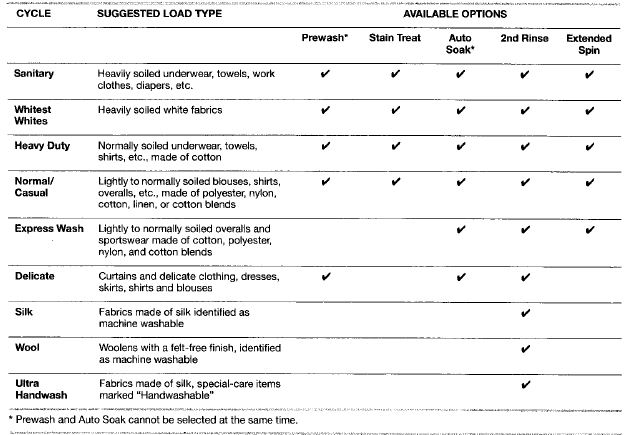
LAUNDRY TIPS
Preparing clothes for washing
Follow these recommendations to help you prolong the life of your garments.
- Close zippers, snaps, and hooks to avoid snagging other items. Remove pins, buckles, and other hard objects to avoid scratching the washer interior. Remove non-washable trim and ornaments.
- Empty pockets and turn them inside out.
- Turn down cuffs; brush away lint and dirt.
- Turn synthetic knits inside-out to avoid pilling.
- Tie strings and sashes so they will not tangle.
- Mend tears, loose hems, and seams.
- Treat spots and stains.
- Stained or wet garments should be washed promptly for the best results.
Sorting
- Separate heavily soiled items from lightly soiled ones, even if they would normally be washed together. Separate lint-givers (towels, chenille) from lint-takers (corduroy, synthetics, permanent press). When possible, turn lint-givers inside out.
- Separate dark colors from light colors, colorfast items from-colorfast items.
- Sort by fabric and construction (sturdy cotton, knits, delicate items).
Unloading
Remove clothes from the washer after the cycle is completed. Metal objects such as zippers, snaps, and buckles may rust if left in the washer basket for a long period of time.
Loading suggestions (maximum size loads).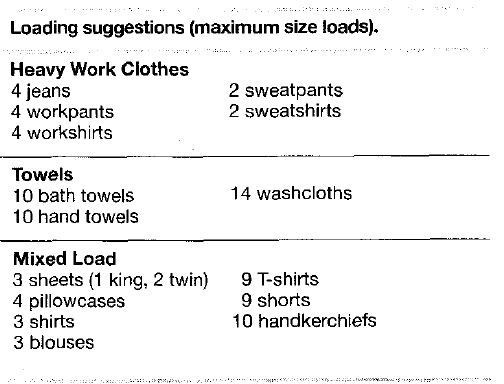
Heavy Work Clothes
- 4 jeans 2 sweatpants
- 4 work pants 2 sweatshirts
- 4 workshirts
Towels
- 10 bath towels 14 washcloths
- 10 hand towels
Mixed Load
- 3 sheets (1 king, 2 twin) 9 T-shirts
- 4 pillowcases 9 shorts
- 3 shirts 10 handkerchiefs
- 3 blouses
WASHER CARE
Cleaning Your Washer
- Cleaning the exterior
Use a soft damp cloth or sponge to wipe up any spills. Occasionally wipe the outside of your front-loading Kenmore washer to keep it looking new. Use mild soap and water. Do not use abrasive products. - Cleaning the interior
Use a soft damp cloth or sponge to occasionally wipe the inner door to remove any detergent residue. Use mild soap and water. Do not use abrasive products. - Cleaning the door seal
Use a soft damp cloth or sponge when necessary. Check the fold of the seal periodically for any foreign objects.
Cleaning the dispenser drawer
The dispenser drawer is removable for easy cleaning.
- Unlock the dispenser drawer by pressing the Release Lever in the Prewash compartment. See “Using the Dispenser.” Remove the drawer.
- Remove the inserts (the siphon from the softener and bleach compartments and the separator).
- Wash the parts under running water.
- Replace the inserts and return the dispenser to the drawer.
Replace inlet hoses after five years of use to reduce the risk of hose failure. Periodically inspect and replace inlet hoses if bulges, kinks, cuts, wear, or leaks are found, When replacing your inlet hoses, record the date of replacement
Vacation, Storage, and Moving Care
Install and store your washer where it will not freeze. Because some water may stay in the hoses, freezing can damage your front-loading Kenmore washer. If storing or moving your washer during freezing weather, winterize it.
Non-use or vacation care:
Operate your washer only when you are at home. If you will be on vacation or not using your washer for an extended period of time, you should:
Unplug the washer or disconnect the power.
- Turn off the water supply to the washer. This helps avoid accidental flooding (due to a water pressure surge) while you are away.
- Slightly open door to provide ventilation.
To winterize the washer:
- Put t qt (1 L) of R, V-type antifreeze in the drum,
- Run the front-loading Kenmore washer on a DRAIN/SPIN cycle.
- Unplug the washer or disconnect the power.
- Shut off both water faucets.
- Disconnect water inlet hoses from faucets and drain.
To use the washer again:
- Flush water pipes.
- Reconnect water inlet hoses to faucets.
- Turn on both water faucets.
- Plug in the washer or reconnect the power.
- Run the washer through the NORMAL/CASUAL cycle with 1/4 the normal recommended amount of detergent to clean out antifreeze.
To transport the washer:
- If the front-loading Kenmore washer will be moved during freezing weather, put 1 qt (1 L) of R.V.-type antifreeze in the drum. Run the washer on a DRAIN/SPIN cycle.
- Unplug the power cord.
- Disconnect the drain hose from the drain system and attach it to the rear panel clips.
- Shut off both water faucets.
- Disconnect the water inlet hoses from the faucets, then drain the hoses and clip them to the rear panel of the washer.
- Do not reuse transport bolts. The unit must be transported in the upright position.
Re-installing the washer
- Follow the “Installation instructions” to locate, level, and connect the washer.
- Run the washer through the NORMAL/CASUAL cycle with V4 the normal recommended amount of detergent to clean the washer and remove the antifreeze, if used•
TROUBLESHOOTING
- First, try the solutions suggested here to possibly avoid the cost of a service call…
- Washer displaying code message and tone sounds “HF” (Water Inlet Problem- no water or insufficient water supply)
- Select PAUSE/CANCEL twice to cancel the cycle. Unplug the front-loading Kenmore washer or disconnect the power.
Check the following:
- Are water faucets completely turned on?
- Are screens at the inlet hose connection to the washer clogged?
- Are water inlet hoses kinked?
- Are water inlet hoses frozen?
- Plug in the washer or reconnect the power. Re-select the cycle and press
- START. If the problem remains, call for service.
“F02” (Drain Problem)
Select PAUSE/CANCEL twice to cancel the cycle. Unplug the washer or disconnect the power.
Check the following:
- Is the drain hose kinked?
- Is the drain hose frozen?
- Is the drain hose clogged?
- Is the drain hose more than 96 in. (2.4 m) above the floor?
“SUD” (Suds Routine)
- When excessive suds are detected, a suds routine automatically starts. This routine removes extra suds and assures proper rinsing of your garments. “SUD” is displayed during rinsing and at the end of the cycle to inform you that Suds Routine was activated. To avoid excessive sudsing, reduce detergent amounts or use HE detergents. “F” Variables [F4 to F16] (Electrical Problem)
- Select PAUSE/CANCEL twice to cancel the cycle. Select DRAIN/SPIN if there is excessive water in the front-loading Kenmore washer.
- Re-select cycle and press START If the problem remains, call for service.
The washer won’t start
- Check the following:
- Is the power cord plugged into a grounded 3-prong outlet?
- Is the washer door firmly shut?
- Has a cycle been selected, but START has not been selected and held for one second?
- Was the door open after the completion of the last cycle?
- The washer won’t fill, wash or rinse
- Check the following:
- Is the power cord plugged into a grounded 3-prong outlet?
- Is there power at the plug? Check the electrical source or call an electrician.
- Are the hot and cold water faucets turned on?
- Is the water inlet hose kinked?
- Are the water inlet valve screens dogged?
Washer stops
- Check the following:
- Is the power cord plugged into a grounded 3-prong 3utlet?
- Is there power at the plug?
- Check the electrical source or call an electrician.
- Has a fuse blown or has the circuit breaker tripped?
- If the problem continues, call the electrician.
- Are you using an extension cord?
- Do not use an extension cord.
The washer won’t drain or spin
- Is the drain hose clogged, or is the end of the drain hose more than 96 in. (2.4 m) above the floor?
- Is your voltage low?
Check the electrical source or call an electrician. Do not use an extension cord. a Is the “SUD” routine active?
The cycle will complete once extra suds are removed• - Is the load balanced?
A single or bulky item may cause an imbalance. Add more items or redistribute the load.
The washer makes noise or vibrates
- Is the washer level?
- The washer must be level. The four feet should be properly _ installed, and the nuts should be tightened against the washer cabinet.
- As water is drained from the washer, you may hear air being pulled through the pump. This happens during the end of draining. It is normal.
- Are you washing items with metal snaps, buckles, or zippers?
- You may hear metal items touching the washer drum. This is normal.
- Is the washer installed on a sturdy and solid floor?
- Refer to the “Installation Instructions” for flooring requirements. Noise and vibration may be reduced by placing a piece of ¾ in. (19.1 mm) plywood underneath your washer.
- The plywood may extend underneath both the washer and dryer to keep them at equal heights.
Water near washer
- Check household plumbing for leaks.
Dispensers clogged or leaking
- Are the laundry products in the correct dispenser compartment?
- Add the correct amounts of detergent, fabric softener, or liquid chlorine bleach to the correct compartments. Add powdered or color-safe bleach to the Main Wash compartment.
- Is the detergent separator in the correct position?
- The separator should be in the front position when using liquid detergent and in the back position when using powdered detergent.
Load too wet Load wrinkled.
Did you use the right cycle for the load being washed? Select a cycle with a higher spin speed. Did you wash a single item or bulky items or have you overloaded the washer?
A single item, bulky items, or overloading may cause imbalance. Add items or try to evenly distribute your wet laundry in the drum, and start a DRAIN/SPIN cycle. If the laundry is still wet, take half of the load out of the washer and try again.
Residue or lint on load
- Did you add detergent to the dispenser?
- For best results, add detergent to the detergent compartment. Do not add detergent to the washer drum.
- Did you sort properly?
- Sort lint givers (towels, chenille) from lint takers (corduroy, synthetics). Also, sort by color.
- Did you overload the washer?
- De not overloads the washer. The washer can be fully led, but not tightly packed. The wash load must be balanced. Lint can be trapped in the load if overloaded.
Check the following:
- Was paper or tissue left in pockets?
- Did you use enough detergent?
- Follow the manufacturer’s directions. Use enough detergent to hold the lint in the water,
- Is your water colder than 70°F (21°C)? Wash water colder than 70°F (21°C) may not completely dissolve the detergent.
- Are you using a low-speed wash cycle? Powdered detergents may not dissolve well in a slow-speed cycle. For best results, use liquid detergent for slow speed cycles like Delicate, Silk, Wool, and Ultra Handwash.
Stains on load
- Did you add detergent to the dispenser?.
- For best results, add detergent to the detergent compartment. Do not add detergent to the washer drum.
- Did you use enough detergent?
- Use enough detergent to remove soil and hold it in suspension.
- For best performance, use a High-Efficiency detergent. Follow the manufacturer’s recommendations for the type of load you are washing.
- Is there above-average iron (rust) in water?
- You may need to install an iron filter.
- Did you properly sort the load?
- Sort dark clothes from whites and light.
- Did you unload the washer promptly?.
- To avoid dye transfer, unload the washer as soon as it stops.
- Did you use a fabric softener dispensing ball?
- Dispensing balls will not operate correctly with this washer.
- Add liquid fabric softener to the fabric softener compartment.
- Did you use powdered detergent in a low-speed cycle? Consider using liquid detergent.
- Did you use Express Wash on a large load? For best results, use Express Wash for small, lightly soiled loads.
Load wrinkled
- Did you unload the washer promptly?
- Unload the washer as soon as it stops.
- Did you use the right cycle for the load being washed?
- Use the tire Delicate cycle or another cycle with a low spin speed to reduce wrinkling.
- Did you overload the washer?
- The wash load must be balanced and not overloaded. Loads should tumble freely during washing.
Gray whites, dingy colors
- Did you properly sort the load?
- Dye transfer can occur when mixing whites and colors in a load. Sort dark clothes from whites and light. Was the wash temperature too low?
- Use hot or warm washes if safe for the load. Hot water should be at least 120°F (49°C) to clean heavy soils. a Did you use enough detergent or do you have hard water?
- Use more detergent for washing heavy soils in cold or hard water.
Cycle too long
- Did you choose the Sanitary cycle or Stain Treat option?
- In both cases, the heater will be activated to provide maximum cleaning performance. Additional time will be added to the regular cycle to heat the water. This additional time will depend on the load size and the hot water inlet temperature.
- Is “SUD” shown in the display?
- Excessive sudsing has been detected and a suds routine has been started to destroy excessive suds. This routine will add time to the original cycle.
- Did the load cause imbalance?
- When too much imbalance occurs, an imbalance routine will start to redistribute the load. This routine will add time to your original cycle.
The door locked at end of the wash cycle
- Did all of the water drain out of the washer during the spin?
Select DRAIN/SPIN to remove any water remaining in the washer. The washer door will unlock at the end of the drain,
Get it fixed, at your home or ours!
For repair in your home of all major brand appliances, lawn, and garden equipment, or heating and cooling systems, no matter who made it, no matter who sold it!
For the replacement parts, accessories, and owner’s manuals that you need to do it yourself.
For Sears professional installation of home appliances and items like garage door openers and water heaters. 1-800-4-MY-HOME ® (1-800-469-4663)
Call anytime, day or night (U.S.A. and Canada)
Our Home
For repair of carry-in items like vacuums, lawn equipment, and electronics, call or go on-line for the location of your nearest Sears Parts & Repair Center.
1-800-488-1222
Call anytime, day or night (U.S.A. only)
www.sears.com
To purchase a protection agreement (U.S.A.) or maintenance agreement (Canada) on a product serviced by Sears
1-800-827-6655 (U.S.A.)
1-800-361-6665 (Canada)
®Registered Trademark/ Trademark! Service Mark of Sears, Roebuck, and Co, under licensee by Sears Canada CATALYST, is a registered trademark of Whirlpool USA, used under licensee by Sears, Roebuck and Co., and Sears Canada.
FAQs Kenmore 461970203975 Front-Loading Automatic Washer Use & Care
How much water can a front-loading Kenmore washer hold?
Features. The washer has a 4.5 cu. ft. capacity.
What are the steps to using a washing machine?
Instructions for using a washing machine in detail
The care instructions are listed on the clothing tag.
Sort your clothes.
Choose the appropriate options.
Then, add boosters, softeners, and detergent.
Turn on your washer after loading it with laundry.
How to operate a fully front-loading Kenmore washer step-by-step?
How to operate fully automatic washers: Step-by-step directions Include your dirty laundry.
Dose the detergent.
Put some detergent in.
Choose the appropriate cycle for your machine.
Decide on the temperature.
As soon as the cycle is over, unload.
How often should a front-loading washing machine’s filter be cleaned?
In order to maintain your machine’s performance and lessen the quantity of lint that settles on your clothes, the front-loading Kenmore washer lint filter should be cleaned at least four times annually.
What are some typical washing machine issues?
The 10 Most Regular Washing Machine Issues
It moves back and forth.
It is noisy, the clothes are torn, the draining is improper or slow, my washing machine won’t spin, there is no water, the door won’t open, and it smells.
How do I reset my front-loading washing machine?
Your washer should be reset. Power cycling is an alternative you could try: When the electrical charge in the front-loading Kenmore washer has cleared (typically 1 to 5 minutes at most), unplug it (or turn off the power at the circuit breaker), and then plug it back in. This is the closest thing to a washer “reset” you can get.
Where is front-loading Kenmore washer’s button located?
A Kenmore refrigerator has a reset button, right? The power of the compressor cannot be specifically controlled by a reset button on a Kenmore refrigerator. But there are ice maker switches available. utilizing their power button.
What is the amount of water used by a 7.5 kg front-loading Kenmore washer?
Front-loading 7.5 kg Direct Drive Washer (WELS 4.5 Star, 64 Litres per wash)
What are the automated washing machine settings?
Agitation, duration, and temperature are the three basic settings of your washing machine. The key capabilities of your machine that let you adjust your wash to the materials you’re cleaning are as follows. Setting the tempo. Less agitation is necessary for delicates.
Can detergent be used in a fully front-loading Kenmore washer?
While hand wash detergent can be used in semi-automatic washing machines, completely automatic washing machines require specialized detergents. Front Load Liquid Detergents are designed to produce minimum foam even at high rpm and provide optimal wash performance in front-load washing machines.
For more manuals by Kenmore, visit ManualsDock


